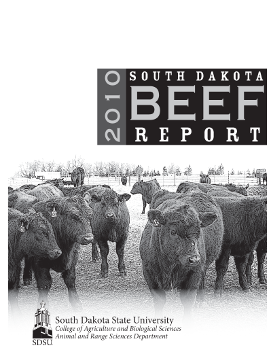Document Type
Report
Report Number
2010-8
Publication Date
2010
Summary
Beef steers (n = 72) of similar age, weight (651 ± 3.1 lb), and genetic background (Angus crossbred) were used to determine the effects of growing period diet on the relationship of plasma ghrelin and leptin concentrations with growth performance and carcass composition. At trial initiation (d 0), 8 steers were harvested for initial carcass composition. The remaining 64 steers were allotted, by weight, to pen and treatment was assigned randomly. Treatments were 1) a high‐forage diet fed during the growing period (0‐116 d) followed by a high‐concentrate diet during the finishing period (117‐209 d; GRW‐FNSH) or 2) a high‐concentrate diet fed for the duration of the trial (0‐209 d; FNSH‐FNSH). Steers were allowed ad libitum consumption regardless of dietary treatment. Eight steers per treatment (1 pen) were harvested on d 88, 116, 165, and 209. At each harvest date, 9‐10‐11th rib sections were dissected for chemical composition, and carcass characteristics were recorded. Replicate blood samples were collected from every steer prior to each harvest, and assayed for ghrelin, leptin, GH, insulin, and NEFA concentrations. Hormone, growth performance, and carcass composition were analyzed statistically using the GLM procedure of SAS to evaluate diet, harvest date, and their interaction. Linear, quadratic, and cubic contrasts were performed. Percent carcass protein decreased linearly (P < 0.001) and percent carcass fat increased linearly (P < 0.001) in both treatments. At each harvest day, FNSH‐FNSH steers had greater carcass fat (P < 0.01) compared with GRW‐FNSH steers. Plasma ghrelin concentrations for FNSH‐FNSH increased quadraticly (P < 0.001) over time, whereas plasma ghrelin concentrations were not different over time for GRW‐FNSH. Plasma leptin concentrations for FNSH‐FNSH increased (P < 0.001) from d 0 to 88 and then plateaued, whereas plasma leptin concentrations increased linearly (P < 0.001) for the GRW‐FNSH. Plasma ghrelin and leptin concentrations fluctuated relative to nutritional status, and plasma ghrelin concentrations were highest in excessively fat cattle. The role of ghrelin during fat accumulation warrants further investigation.
Number of Pages
10
Format
application/pdf
Language
en
Publisher
South Dakota State University
Rights
Copyright © 2010 South Dakota State University.
Recommended Citation
Jennings, J.S.; Pritchard, R.H.; Bruns, K.W.; Keisler, D.H.; and Wertz-Lutz, A.E., "Relationship of Circulating Ghrelin and Leptin Concentrations in Beef Cattle ExhibitingDifferences in Composition of Gain" (2010). South Dakota Beef Report, 2010. 9.
https://openprairie.sdstate.edu/sd_beefreport_2010/9


